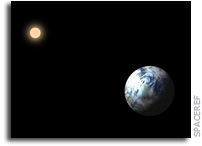Aerosol Particles and Planetary Cloud Formation

Scientists recently discovered the source of naturally occurring aerosol particles in Earth’s atmosphere that play an important role in cloud formation.
The particles in questions are known as ‘climate-active organic aerosols,’ and are vapors composed of large molecules that contain almost equal numbers of carbon, oxygen and hydrogen.
The international research team found that these vapors form shortly after the release of plant emissions into the air. The vapors condense on small particles, causing them to grow bigger and bigger. Eventually, they reach a size that is large enough to cause noticeable changes in the atmosphere – like reflecting sunlight, and acting as nuclei for cloud formation.
The research was published in the journal Nature, and shows a direct mechanism for how life on Earth can influence the production of particles that play a big role in processes affecting Earth’s climate.
The study is useful for astrobiologists who are interested in the connections between Earth’s biosphere and climate, and how climate change will affect the future habitability of our planet. But could studies like these also have implications in comparative planetology and the search for life beyond Earth?
As the new study shows, life on Earth can have a noticeable affect on the composition and behavior of our planet’s atmosphere. There are now over 1,000 identified exoplanets in orbit around distant stars (and the number keeps growing). Scientists are now exploring techniques that could be used to study the atmospheres of these planets in detail. The ultimate goal is to find atmospheric biosignatures that would identify alien life.
Astrobiology Magazine spoke with Dr. Nancy Kiang of NASA’s Goddard Institute for Space Studies about the prospect of using climate-active organic aerosols as a biosignature. Dr. Kiang is a specialist when it comes to the interactions between Earth’s biosphere and atmosphere, and how these interactions could produce signs of life at global scales.
First off, plants themselves could provide biosignatures on an exoplanet. If you observe how light reflects off a planet’s surface, and if that surface is covered by a lot of plants, you can actually ‘see’ the plants due to the way in which their chlorophyll absorbs light. This is a spectral signature known as the “vegetation red edge.”
“Satellites can see this to identify where plants are on our planet,” said Dr. Kiang. “If we were to see a feature like this on another planet, it would tell us that advanced life had evolved on land. At least 20 percent of the planet’s surface would have to be covered with vegetation AND cloud-free for a strong enough signal for a telescope to see.”
Dr. Kiang points out that the results of the new study could actually pose more problems for this type of direct detection of plants on another planet.
“The catch is that plants promote cloud formation through transpiration of soil moisture back to the atmosphere,” said Dr. Kiang. “Thus vegetation can help its own persistence and even its spread through enhancing the availability of moisture.”
Dr. Kiang cited some examples on Earth where this can be seen, such as heavy precipitation over tropical forests and the formation of clouds over the non-grazed vegetation that runs along Australia’s famous ‘bunny fence.’
“However, clouds also hide vegetation from remote observations by satellites, and we expect the same with telescopes looking for photosynthesis on exoplanets,” Dr. Kiang continued. “Alas, with organic aerosol formation, plants have yet another way of hiding themselves from our detection by promoting cloud formation.”
So, by playing a role in organic aerosol formation, plants actually help create the clouds that hide them from detection. So what about studying the clouds themselves?
“It’s hard for astronomers to figure out the chemical composition of clouds and hazes because of the way they scatter light, and they also obscure a lot of the chemical signature of the atmosphere (this varies with high or low clouds and cloud cover, of course),” said Dr. Kiang. “For example, Hubble data have revealed clouds on the planet GJ1214b, but we can’t tell if they are water or some other chemical. If we can’t see the planet’s surface or the atmospheric gaseous composition, the challenge will be for astronomers to develop techniques to see if clouds could provide signs of life.”
According to Dr. Kiang, our best prospect for identifying life by studying the atmospheres of exoplanets right now lies with a different signature.
“Atmospheric oxygen from photosynthesis is thus far the strongest planetary scale signature of life that we know,” said Dr. Kiang. “The amount of oxygen in the Earth’s atmosphere is largely the result of a long-term buildup due to ocean photosynthesis and sequestering of organic carbon deep in the ocean that began even before plants evolved on land.”
Aaron L. Gronstal, Astrobiology Magazine








